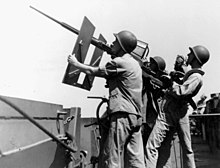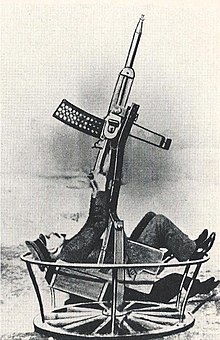20 mm Oerlikon cannon

The 20 mm Oerlikon cannon was an anti-aircraft gun made by the Swiss company Oerlikon .
history
Like the 40 mm Bofors gun , this weapon was used by almost all of the countries involved in World War II . It was designed in 1914 by the German Reinhold Becker as a 20 mm Becker cannon and used exclusively on the German side during the First World War , but the Swiss company Semag received the patent in 1919. Semag was later taken over by Oerlikon . This gun was largely modified and improved by Oerlikon and marketed all over the world, as well as being produced in versions in many countries. The Oerlikon flak was probably the most widely produced anti -aircraft gun of the Second World War. 124,735 ammunition and one billion rounds of ammunition were produced in the USA . No exact figures are known from other countries.
The Oerlikon flak was seen as a reliable, robust, and simple design that was easy to maintain. During the Second World War from December 1941 to September 1944, 32 percent of all Japanese fighters shot down by the US Navy were due to them. On the ships of the Allies, it was the most important series fire gun, along with the long-range 40 mm Bofors ; Because of its mobility it was used successfully against directly attacking kamikaze pilots of the Japanese.
In 1939 a simplified version of the Oerlikon cannon was developed and produced in Poland . Since it was possible to bring the plans to England before the German occupation, they were produced there in large numbers as a Polsten Gun .
Before the Second World War, from 1937, Switzerland acquired 363 Oerlikon cannons and used them as 20mm Flab Kan Oe 37 with 15-round box magazines on infantry guns. After being replaced by the 20 mm Flab Kan 38 manufactured by the Bern weapons factory and the Hispano 20 mm Flab Kan 43/44 - gas pressure loader with a significantly higher rate of fire - it was used for civil security. In Germany the weapon was introduced to the infantry as Flak 28, but quickly replaced by the 2 cm Flak 38 . During the Second World War, further developments were mainly used for close-range anti-aircraft defense in the Navy, and such anti-aircraft guns can still be seen on ships in some countries.
After the Second World War, the company continued to produce anti-aircraft guns , initially offering various 20-mm gas pressure loaders, and later the Oerlikon 35-mm twin gun .
technology


The Oerlikon cannon is a self-firing recoil loader with a ground lock . The cartridge is ignited while the breech is still in advance, which leads to a smoother function and can also reduce the breech mass. A disadvantage of the system was that greased ammunition had to be used to avoid case tears. This made the weapon unsuitable for ground troops because of possible pollution of the ammunition.
- Caliber: 20 mm
- Weight of the gun: 68.04 kg
- Pipe length: 1400 mm
- Elevation range: −10 ° to + 90 °
- Side area: 360 °
- Muzzle velocity: 835 m / s
- Rate of fire: 450 rounds / min
- Horizontal range of sight: 1800 m
- Maximum range: 4400 m
- Shot height: 3050 m
Museum reception
- The complete collection of works by the former arms manufacturer Oerlikon-Bührle can be seen in the Swiss Military Museum Full across from Waldshut on the Rhine. In addition to various 20 mm anti-aircraft guns, it also includes larger caliber guns, but also aircraft weapons and prototypes of anti-tank weapons from the manufacturer.
- A 20 mm anti-aircraft cannon 65/68 (Oerlikon Contraves GAI-B01) of the Austrian Armed Forces is on display in the military aviation exhibition in Zeltweg in hangar 8 of the Hinterstoisser air base , a branch of the Vienna Museum of Military History .
See also
Web links
- www.netherlandsnavy.nl: Oerlikon 20 mm (English)
Individual evidence
- ↑ on doppeladler.com , accessed on September 10, 2013


